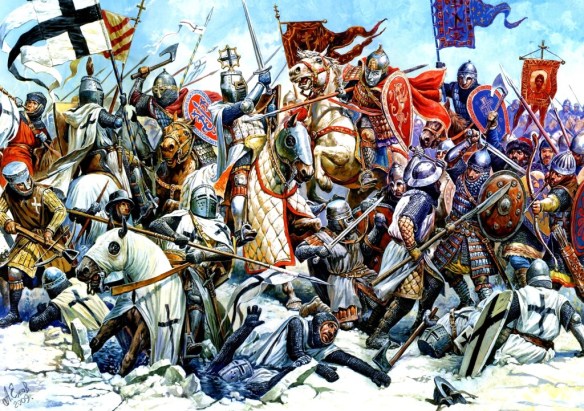Battle of Lake Peipus, 5 April 1242, in which forces of Novgorod under Alexander Nevskii defeated Northern Crusaders led by Bishop Hermann of Tartu. Following wide-ranging manoeuvres largely confined to areas of frozen marsh between dense forests, both sides crossed the frozen channel linking Lake Peipus with its southern extension, often called Lake Pskov.
Initial dispositions:
(A) Alexander Nevskii’s household cavalry drawn up behind Novgorod militia;
(B) Russian left wing;
(C) Russian right wing, including contingent of Turco-Mongol horse-archers;
(D) Crusader array, with Livonian feudal contingent on right, Teutonic Knights in centre, and Danish feudal forces from northern Estonia on left;
(E) Estonian auxiliaries.
Movements:
(1) Russian army crosses frozen lake, then adopts a defensive position at Raven’s Rock;
(2) Probable route of pursuing Crusader army across frozen lake;
(3) Alternative Crusader route, via Piiris Island;
(4) Crusader frontal attack forces back Novgorod militia;
(5) Attack by Russian right, including horse-archers, hits Danes in flank, causing them to flee. They are followed by the Crusader right flank and Estonian auxiliaries, leaving the Teutonic Knights surrounded.
ALEXANDER NEVSKY OF SUZDAL (1220-63)
Prince of Novgorod from 1236, Prince of Kiev from 1247, Grand Duke of Vladimir from 1252, a successful military leader and victor over the Teutonic Knights, son and successor of Jaroslav II of Novgorod. He fought off Mongol attacks but was prepared to compromise. He defeated the Swedes at the Neva in 1240, earning the name Nevsky. The Knights tried to extend control eastwards against the Russians. Alexander recaptured Pskov and beat the Knights at Lake Peipus in 1242, leading to their decline. He defeated the Lithuanians in 1245. He suppressed a riot in Novgorod against a Mongol census in 1258 and kept Novgorod independent. He died at Gorodets on 14 November. He was canonised by the Russian Orthodox Church in 1547.
